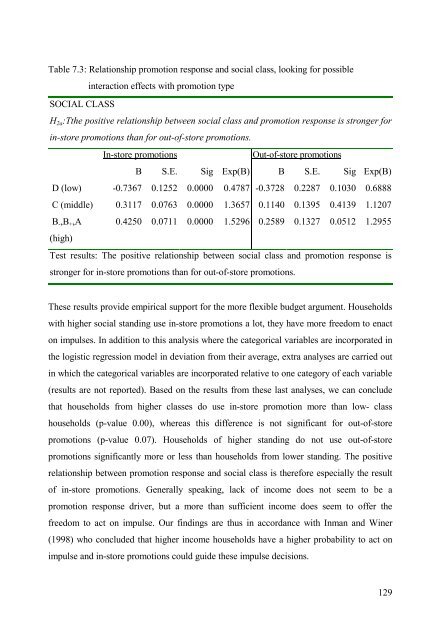Analysis of Sales Promotion Effects on Household Purchase Behavior
Analysis of Sales Promotion Effects on Household Purchase Behavior
Analysis of Sales Promotion Effects on Household Purchase Behavior
You also want an ePaper? Increase the reach of your titles
YUMPU automatically turns print PDFs into web optimized ePapers that Google loves.
Table 7.3: Relati<strong>on</strong>ship promoti<strong>on</strong> resp<strong>on</strong>se and social class, looking for possible<br />
interacti<strong>on</strong> effects with promoti<strong>on</strong> type<br />
SOCIAL CLASS<br />
H2a:Tthe positive relati<strong>on</strong>ship between social class and promoti<strong>on</strong> resp<strong>on</strong>se is str<strong>on</strong>ger for<br />
in-store promoti<strong>on</strong>s than for out-<str<strong>on</strong>g>of</str<strong>on</strong>g>-store promoti<strong>on</strong>s.<br />
In-store promoti<strong>on</strong>s Out-<str<strong>on</strong>g>of</str<strong>on</strong>g>-store promoti<strong>on</strong>s<br />
B S.E. Sig Exp(B) B S.E. Sig Exp(B)<br />
D (low) -0.7367 0.1252 0.0000 0.4787 -0.3728 0.2287 0.1030 0.6888<br />
C (middle) 0.3117 0.0763 0.0000 1.3657 0.1140 0.1395 0.4139 1.1207<br />
B-,B+,A<br />
(high)<br />
0.4250 0.0711 0.0000 1.5296 0.2589 0.1327 0.0512 1.2955<br />
Test results: The positive relati<strong>on</strong>ship between social class and promoti<strong>on</strong> resp<strong>on</strong>se is<br />
str<strong>on</strong>ger for in-store promoti<strong>on</strong>s than for out-<str<strong>on</strong>g>of</str<strong>on</strong>g>-store promoti<strong>on</strong>s.<br />
These results provide empirical support for the more flexible budget argument. <strong>Household</strong>s<br />
with higher social standing use in-store promoti<strong>on</strong>s a lot, they have more freedom to enact<br />
<strong>on</strong> impulses. In additi<strong>on</strong> to this analysis where the categorical variables are incorporated in<br />
the logistic regressi<strong>on</strong> model in deviati<strong>on</strong> from their average, extra analyses are carried out<br />
in which the categorical variables are incorporated relative to <strong>on</strong>e category <str<strong>on</strong>g>of</str<strong>on</strong>g> each variable<br />
(results are not reported). Based <strong>on</strong> the results from these last analyses, we can c<strong>on</strong>clude<br />
that households from higher classes do use in-store promoti<strong>on</strong> more than low- class<br />
households (p-value 0.00), whereas this difference is not significant for out-<str<strong>on</strong>g>of</str<strong>on</strong>g>-store<br />
promoti<strong>on</strong>s (p-value 0.07). <strong>Household</strong>s <str<strong>on</strong>g>of</str<strong>on</strong>g> higher standing do not use out-<str<strong>on</strong>g>of</str<strong>on</strong>g>-store<br />
promoti<strong>on</strong>s significantly more or less than households from lower standing. The positive<br />
relati<strong>on</strong>ship between promoti<strong>on</strong> resp<strong>on</strong>se and social class is therefore especially the result<br />
<str<strong>on</strong>g>of</str<strong>on</strong>g> in-store promoti<strong>on</strong>s. Generally speaking, lack <str<strong>on</strong>g>of</str<strong>on</strong>g> income does not seem to be a<br />
promoti<strong>on</strong> resp<strong>on</strong>se driver, but a more than sufficient income does seem to <str<strong>on</strong>g>of</str<strong>on</strong>g>fer the<br />
freedom to act <strong>on</strong> impulse. Our findings are thus in accordance with Inman and Winer<br />
(1998) who c<strong>on</strong>cluded that higher income households have a higher probability to act <strong>on</strong><br />
impulse and in-store promoti<strong>on</strong>s could guide these impulse decisi<strong>on</strong>s.<br />
129

















